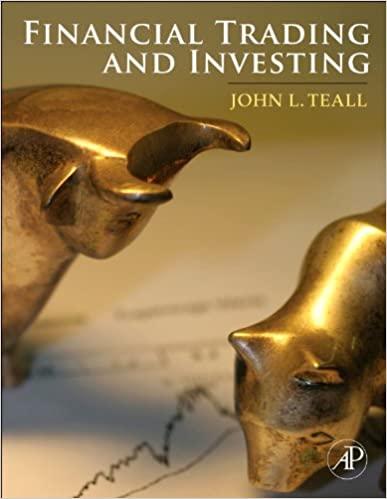3. Sniffing algorithms attempt to discern competitors algorithms. In some instances, mere observations of competitor trading activity
Question:
3. Sniffing algorithms attempt to discern competitors’ algorithms. In some instances, mere observations of competitor trading activity can reveal information as to competitor strategies, latent demand (icebergs or dark pools), and so on. Beagle Trading is a proprietary trading company that seeks to sniff out its competitors’ trading algorithms in an effort to detect their likely order flows. In an effort to sniff out trade slicing models used by brokers, Beagle intends to rely on the following market impact model estimated from an OLS based on its own trading experience:
B=n5F1vðX=nÞ2 where Beagle estimates the cost of each of n equal-sized executions, B/n to have a fixed component F510 and a declining variable cost component v(X/n)2, where v50.0001 and Xi/n is the number of shares traded in any given execution i. Beagle observes a particular broker repeatedly placing buy orders of c5214 shares of Stock GMNX in various equities marketplaces. Beagle assumes that these order sizes are optimal given its market impact model.
a. Based on the observed order sizes c5X/n5214, what can Beagle infer about the latent demand for this stock? That is, is Beagle able to sniff out the total number of shares that the broker seeks to purchase based on its market impact model and observed order sizes? Why or why not?
b. Suppose that F in the market impact model is revised to be interpreted and calculated differently. Rather than representing fixed administrative costs of a transaction, F will equal rns, where coefficients r50.1 and s50.5 were determined as part of the same OLS that determined numerical values for v50.0001 and m52.
The function F is now considered to reflect the total slippage associated with n transactions for stock per hour. Thus, this revised market impact model is now estimated as follows:
B=n5F1vðX=nÞ2 5rns 1vðX=nÞ2 5rns 1vðX=nÞ2 50:1n5 10:0001ðX=nÞ2 Suppose that Beagle observes that a broker has submitted orders of c5214 shares.
Based on these observed order sizes, and with its revised market impact model, what can Beagle infer about the latent demand for this stock? That is, is Beagle now able to sniff out the total number of shares that the broker seeks to purchase based on its market impact model and observed order sizes? Why or why not? If Beagle can infer a latent demand, how many shares does the broker intend to purchase, including transactions already observed?
Step by Step Answer:







